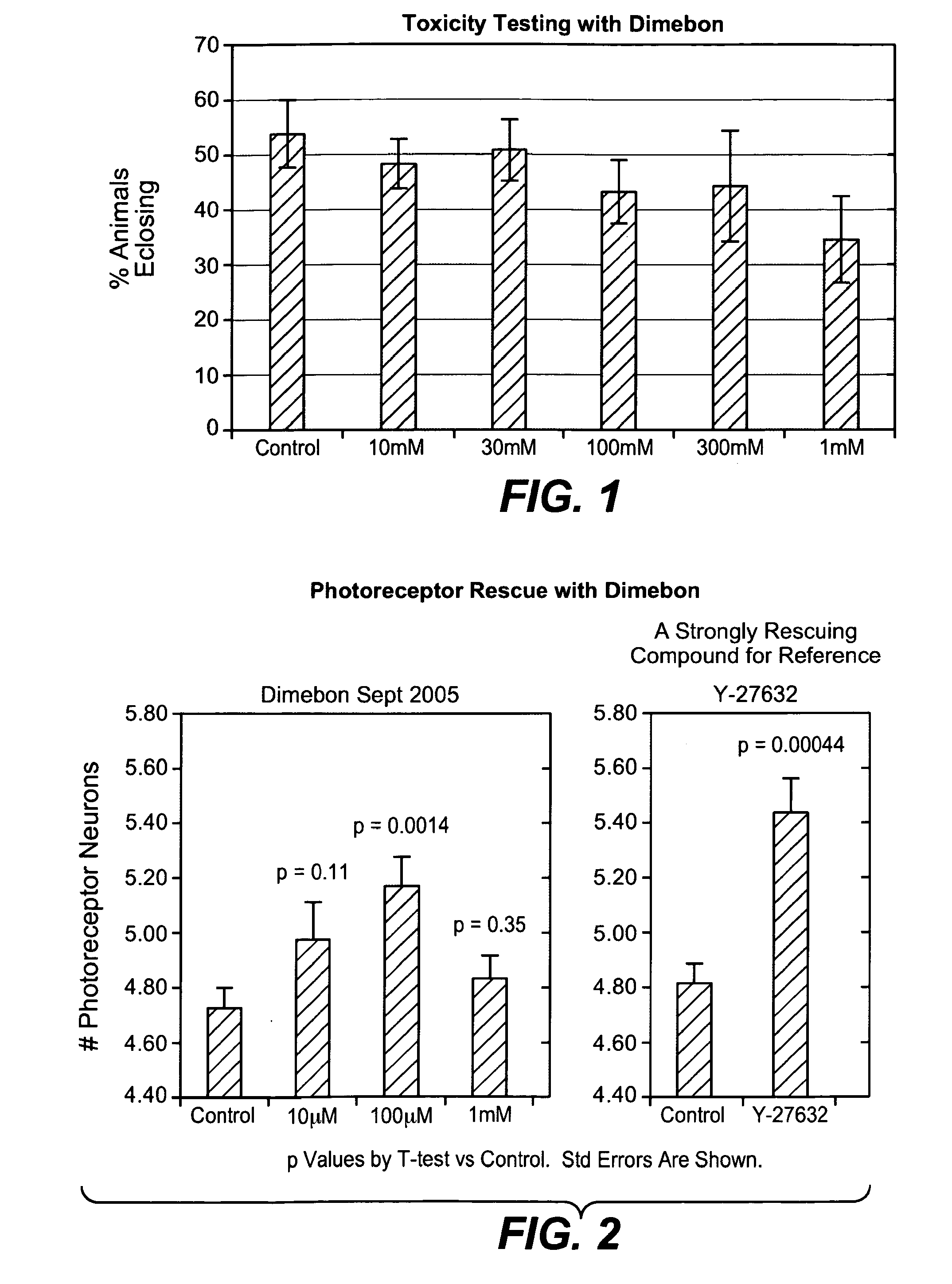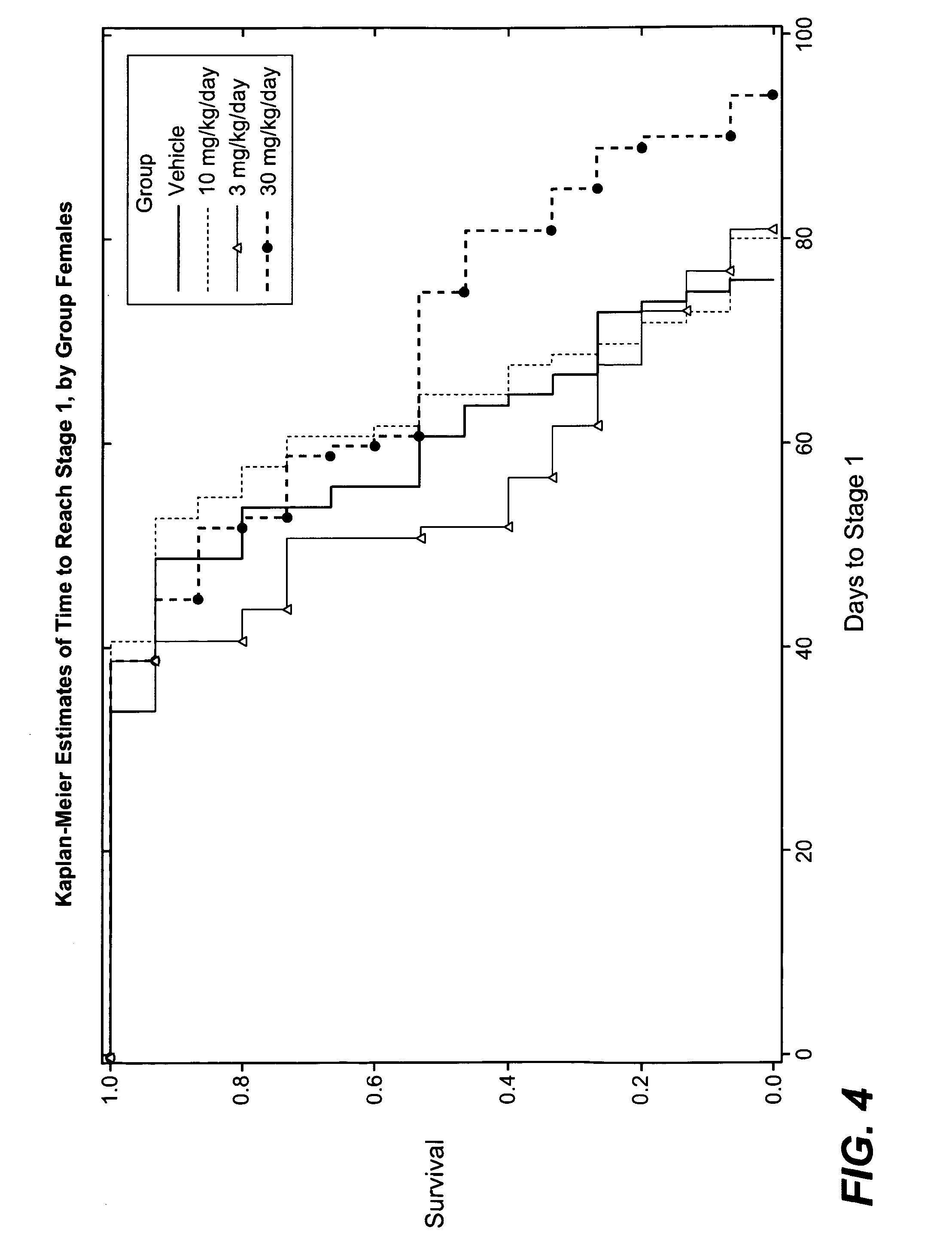Hydrogenated pyrido (4,3-b) indoles for treating amyotrophic lateral sclerosis (ALS)
a technology of amyotrophic lateral sclerosis and indoles, which is applied in the direction of biocide, drug composition, muscular disorder, etc., can solve the problems of control muscle movement, brain loss of the ability to initiate muscle movement, and the inability to cure the disease, so as to prolong the survival time, prevent and/or delay the onset and/or development, the effect of improving the quality of li
- Summary
- Abstract
- Description
- Claims
- Application Information
AI Technical Summary
Benefits of technology
Problems solved by technology
Method used
Image
Examples
example 1
Determination of Toxicity Properties of Dimebon
[0147]Dimebon, 2,8-dimethyl-5-(2-(6-methyl-3-pyridyl)-ethyl)-2,3,4,5-tetrahydro-1H-pyrido(4,3-b)indol dihydrochloride, was used as a representative compound of hydrogenated pyrido(4,3-b)indoles.
[0148]where R1 and R3 are methyls, and
[0149]R2 is 2-(6-methyl-3-pyridyl)-ethyl
[0150]Dimebon was evaluated for toxicity levels in wildtype Drosophila fruit flies as described in U.S. Provisional Patent Application No. 60 / 723,403. Dimebon was administered daily at doses ranging from 10 μM to 1 mM to explore its toxicity. An untreated control group was also studied in this experiment. The concentrations given were concentrations of dimebon in the food that animals drink / eat ad libitum. The food consisted of cornmeal, dextrose, yeast and agar.
[0151]About 500 wild type Drosophila eggs were collected on grape juice plates, washed with distilled water and transferred 100 per vial to grow at 25 degrees C. The adult progeny were scored after eclosing (eme...
example 2
Determination of Dimebon's Ability to Inhibit Huntingtin-Induced Neurodegeneration of Photoreceptor Neurons in Drosophila Eyes
[0153]As discussed in U.S. application Ser. No. 60 / 723,403 and further below, it has been discovered that dimebon, a representative member of a class of compounds disclosed herein, had strikingly positive results in the art-accepted Drosophila model of Huntington's disease, and exhibited enhanced protective effects when compared to a control. This result supports the ability of the hydrogenated pyrido[4,3-b]indoles described herein to inhibit neuronal cell death, which is a characteristic of ALS.
[0154]The Drosophila fruit fly is considered an excellent choice for modeling neurodegenerative diseases because it contains a fully functional nervous system with an architecture that separates specialized functions such as vision, smell, learning and memory in a manner not unlike that of mammalian nervous systems. Furthermore, the compound eye of the fruit fly is ma...
example 3
Use of an in vitro Model to Determine the Ability to Compounds of the Invention to Treat, Prevent and / or Delay the Onset and / or the Development of Amyotrophic Lateral Sclerosis
[0163]In vitro models of ALS can be used to determine the ability of any of the hydrogenated pyrido[4,3-b]indoles (such as dimebon) or combination therapies described herein to reduce cell toxicity that is induced by a SOD1 mutation. A reduction in cell toxicity is indicative of the ability to treat, prevent and / or delay the onset and / or the development of ALS in mammals, such as humans.
[0164]In one exemplary in vitro model of ALS, N2a cells (e.g., the mouse neuroblastoma cell cline N2a sold b y InPro Biotechnology, South San Francisco, Calif., USA) are transiently transfected with a mutant SOD1 in the presence or absence of various concentrations of a hydrogenated pyrido[4,3-b]indole, such as dimebon. Standard methods can be used for this transfection, such as those described by Y. Wang et al., (Journal of Nu...
PUM
| Property | Measurement | Unit |
|---|---|---|
| Fraction | aaaaa | aaaaa |
| Fraction | aaaaa | aaaaa |
| Fraction | aaaaa | aaaaa |
Abstract
Description
Claims
Application Information
 Login to View More
Login to View More - R&D
- Intellectual Property
- Life Sciences
- Materials
- Tech Scout
- Unparalleled Data Quality
- Higher Quality Content
- 60% Fewer Hallucinations
Browse by: Latest US Patents, China's latest patents, Technical Efficacy Thesaurus, Application Domain, Technology Topic, Popular Technical Reports.
© 2025 PatSnap. All rights reserved.Legal|Privacy policy|Modern Slavery Act Transparency Statement|Sitemap|About US| Contact US: help@patsnap.com



